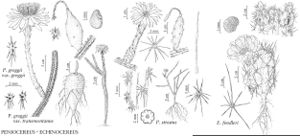Peniocereus
Contr. U.S. Natl. Herb. 12: 428. 1909.
| Taxon | Illustrator ⠉ | |
|---|---|---|
 | Peniocereus greggii var. greggii Peniocereus greggii var. transmontanus Peniocereus striatus Echinocereus fendleri | John Myers John Myers John Myers John Myers |
Shrubs, low, erect to sprawling, arching, or scrambling, sparingly branched. Roots turnip-shaped or tuberlike and clustered. Stems unsegmented, gray, gray-green, greenish brown, brown, or purplish, columnar, proximally terete, distally terete or angled [or dimorphic with young stems 3–5-angled and adult stems terete in two Mexican species], [12–] 25–300 [–400] × 0.3–2 [–6] cm, rigid, slender, canescent [or papillate]; ribs [3–] 4–9 [–20], often prominent, rib crests usually straight, uninterrupted; areoles (3.5–) 5–20 mm apart along ribs, circular to elliptic, lanose or sometimes glabrate; areolar glands absent; cortex and pith not mucilaginous. Spines 5–15 (–17) per areole, yellowish white, sometimes with black tips, conic, subulate with swollen bases, sometimes acicular to bristlelike, 1.5–4 [–25] mm, puberulent to glabrate, scurfy; radial and central spines similar. Flowers nocturnal (remaining open next day), usually borne laterally along distal portions of ribs, at adaxial edges of areoles, usually fragrant, salverform with long tube flaring abruptly near apex, usually 7–25 cm; tepals lanceolate to oblanceolate, apiculate to attenuate; outer tepals greenish, usually tinged with red, purple, brown, or white, 25–50 × 2–6 mm, margins entire or minutely ciliate; inner tepals commonly white [or red], sometimes lightly tinged cream, rose, red, or green, 25–75 × 8–12 mm, margins entire to slightly undulate; ovary with low tubercles, minutely scaly or scaleless, spiny, areoles woolly; stigma lobes 9–12, white to yellow-white, 10–15 mm. Fruits indehiscent, red to scarlet [carmine to purple], pyriform or ellipsoid [to ovoid], [30–] 40–90 × 25–50 mm, fleshy, low tuberculate, scaleless, spiny; pulp reddish, in some taxa sweet and edible; floral remnant persistent. Seeds black, broadly oblong, 1–4 × 0.8–2.5 mm, shiny or dull; testa rugose, pitted and/or with raised polygonal cells. x = 11.
Distribution
Arid regions, sw United States, nc and w Mexico southward to Chiapas
Discussion
Species ca. 20 (2 in the flora).
Selected References
Lower Taxa
Key
| 1 | Stems at midlength 10 mm diam.; ribs 4-6, prominent, widely divergent; flowers 15-25 cm | Peniocereus greggii |
| 1 | Stems at midlength 6 mm diam.; ribs 6-9, low, rounded, crowded together; flowers 7-10 cm | Peniocereus striatus |